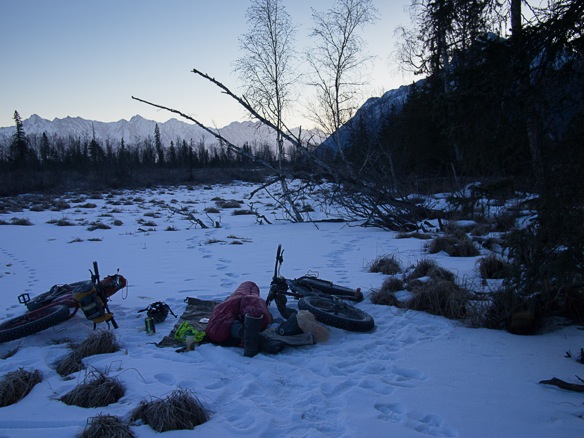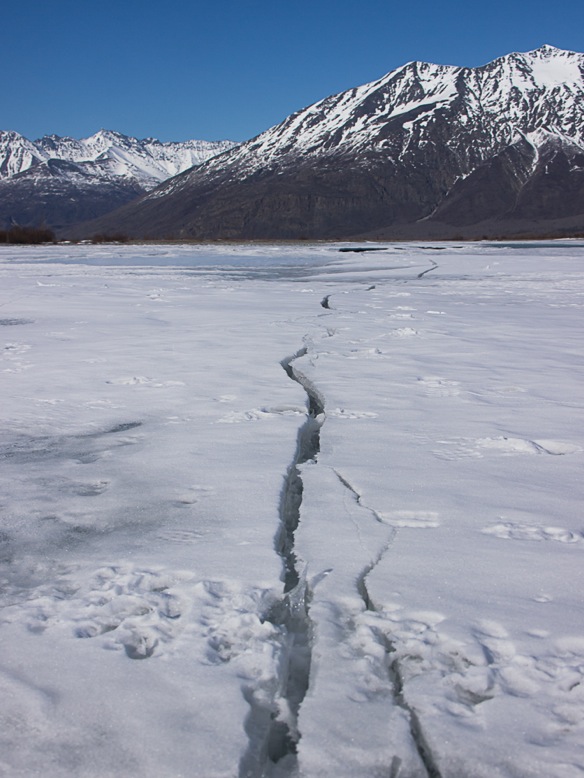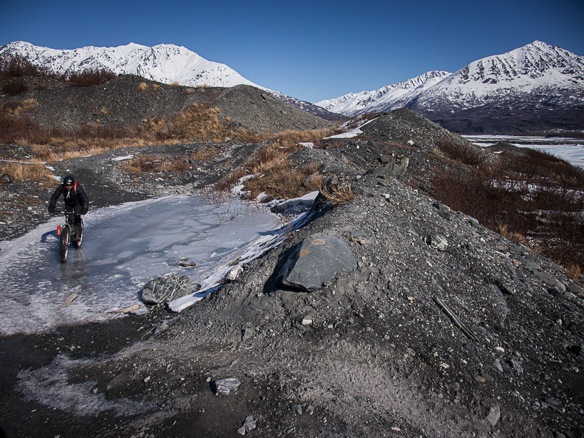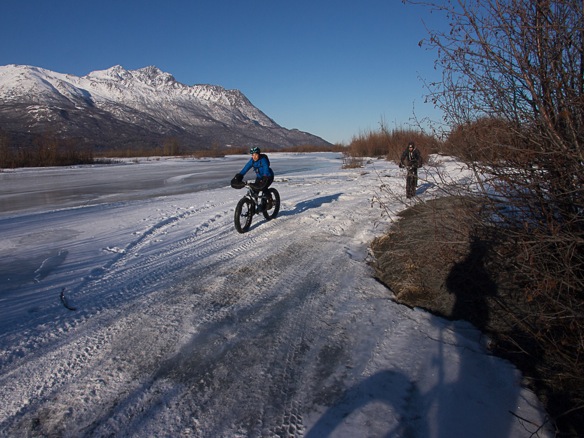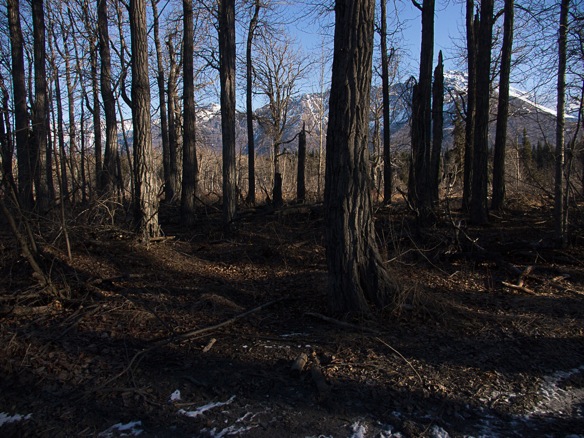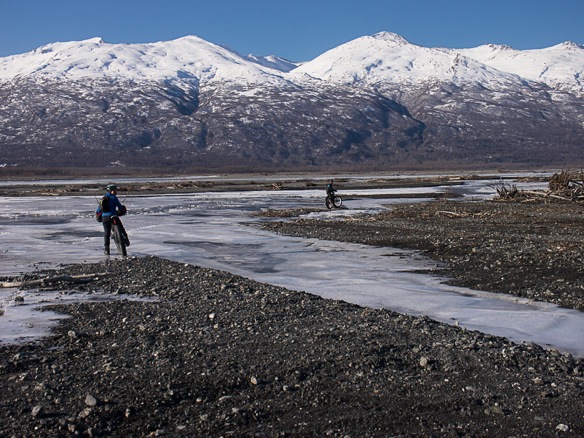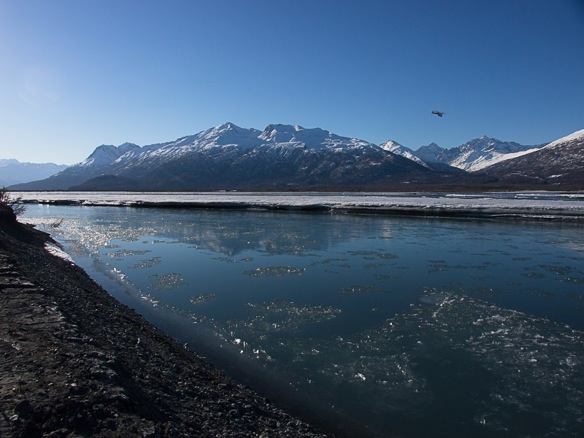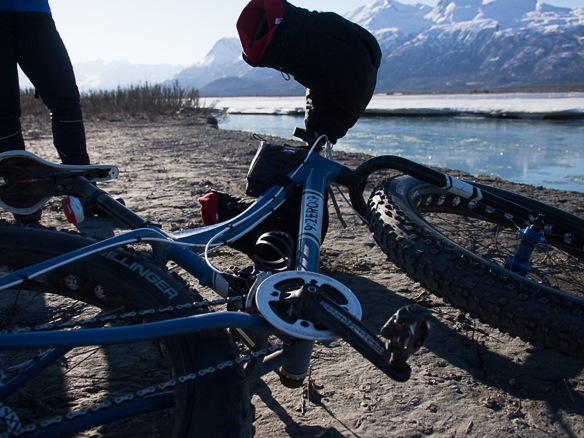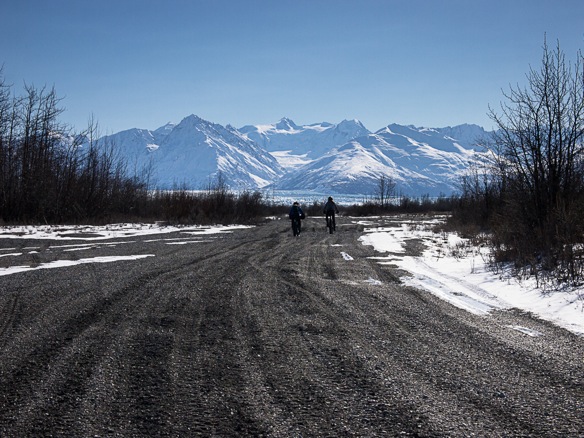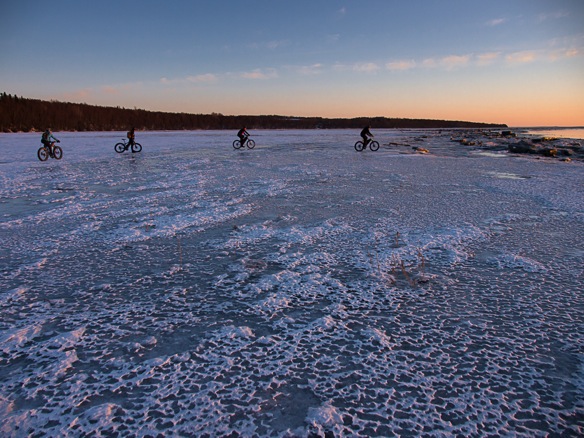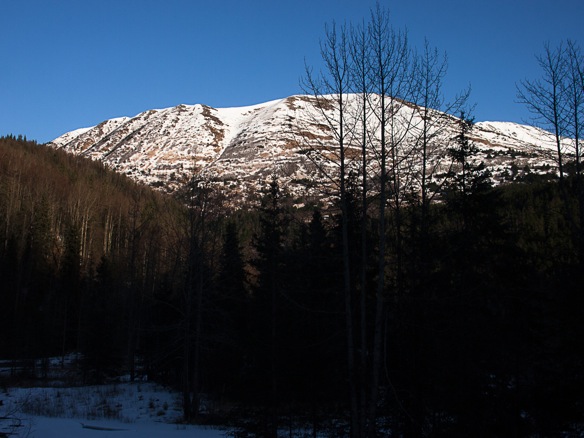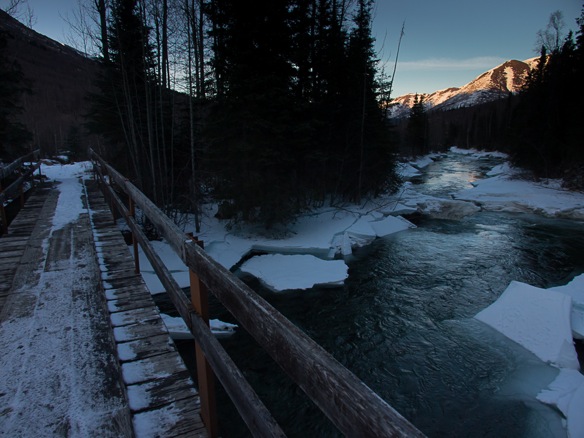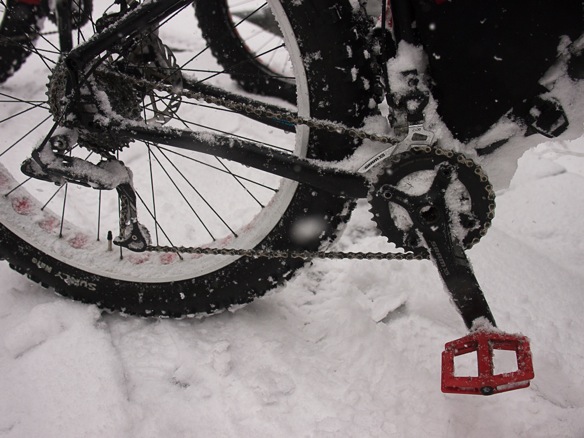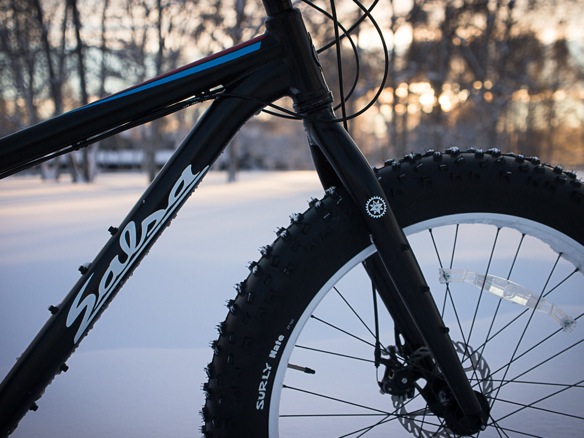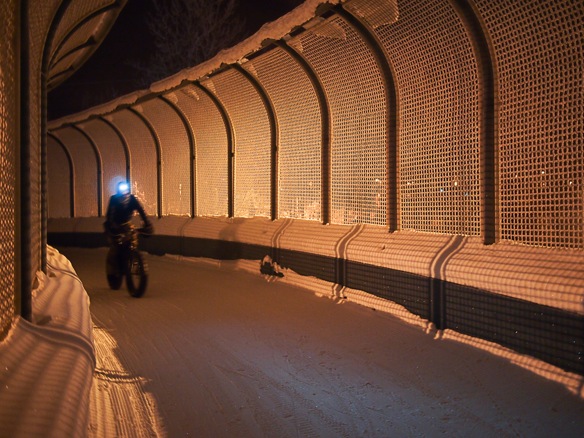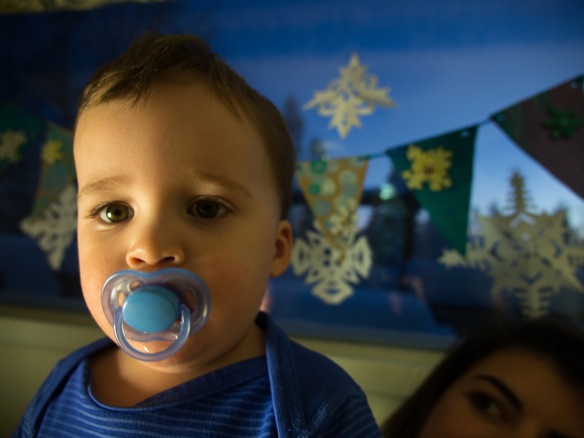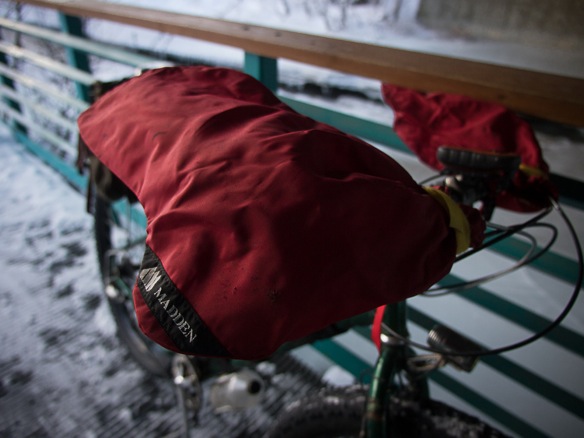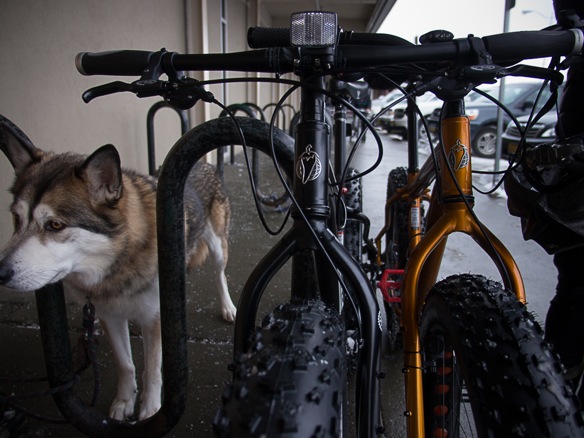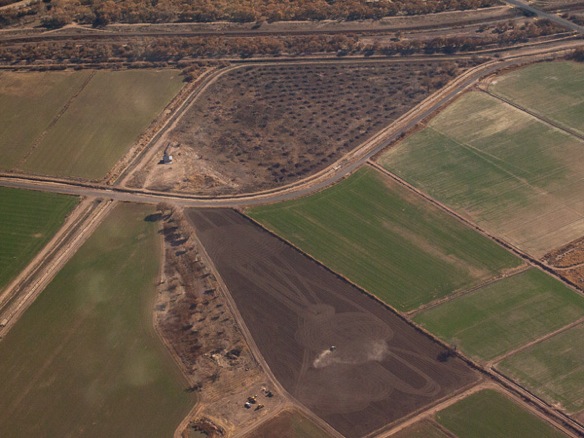
Alex warms fingers while pedaling over Cache Mountain Divide in the White Mountains Recreation Area north of Fairbanks, AK this spring. After riding with us in Baja for two months, he joined us for several weeks of winter riding in Alaska.
Crossing the Mexican border at Tecate last December, we could not have known what was to come. We weren’t planning to ride down the peninsula twice to make the Baja Divide, Lael wasn’t planning to race the Trans-Am. And I couldn’t explain exactly how we had gotten there. How, after five years, are we standing at the border gates with such great excitement to return to Mexico, hoping and knowing the desert will provide the opportunity to enjoy long restful nights and open roads. Baja was a consolation for our other plans. We’d tossed around lots of options, such as riding in Egypt and Sudan or wintering in Eastern Europe, but Lael had too recently attempted the Arizona Trail to commit to those kinds of trips. So we went to Baja, and now we are here. Specifically, Lael is standing adjacent to the mouth of the Columbia River in Astoria, OR riding a carbon road bike with electronic shifting and no sleeping bag, planning to ride to Virginia as fast as she can. And I’m in Alaska, rounding third on a three month commitment to The Bicycle Shop, before I jump on a plane to Newport News, VA to ride 13 miles to meet Lael at the finish in a few weeks. If it works the way I’m planning, we’ll roll into Yorktown around the same time. But I cannot really expect anything. The only rule is the consistent progress of time and the consistent process of making decisions as they come. It happens fast, and you have to act fast. That’s as much as I know anymore. It is a passionate and impulsive existence, and it moves fast.
I had spent the summer working and Lael spent the summer racing, this is back in 2015, when she was riding an average of 175 miles per day down the Great Divide Route. It was a great summer. That’s how I remember it, at least, but there are heartstrings and missing fragments working to ease the hard memories and sweeten the great ones. I remember collecting her from the end of the Divide, from the second ride when she traveled the route by herself and crushed it and she felt all alone. That ride was bittersweet.
We collected ourselves at the end of the summer in Alaska and landed in Las Vegas for a fun week at Interbike with the Revelate crew, followed by a week long bicycle ride to the start of the Arizona Trail by casual riding on paved roads and a few dirt tracks. Arriving at Jacob Lake, AZ and making an out and back trip to the Utah border to officially high-five the northern terminus of the trail, we set out to complete the entire Arizona Trail. We first contacted the Arizona Trail back in 2013, when we arrived via plane from Ukraine to Denver, hitched to Grand Junction, and rode Kokopelli and Lockhart Basin toward Arizona. We traversed sections of the AZT, Coconino Loop, and the Black Canyon Trail down to Tucson. But that was just a taste of the whole AZT which is best known for monumental challenges like the Grand Canyon and Oracle Ridge, along with more mundane challenges such as overgrown trail north of Oracle and mud-hardened hoof prints on the plateau near Mormon Lake. But in between things you wouldn’t ever wish to do again, are things worth doing every day. This time we would do them all.
By the time we rolled onto the Arizona Trail in the north, a brief conversation which had taken place a week earlier at Interbike was developing into a media project involving Lael and a solo time trial down the Arizona Trail later in the month. She should have been excited. But the coming days and weeks of touring the route would leave her in tears. The prospect of having to navigate the narrow, overgrown, rocky trail at night, at the end of October when daylight is limited to barely 10 hours a day was now a little more than challenging, and all of this at someone else’s request. She could have said no, I suppose. But it was her summer of Tour Divide racing that allowed her the opportunity to be involved with this project, this opportunity to work, and she needed the money. The media project was sponsored by REI and Outside Magazine, and they connected Lael with a nice bike from Specialized. Surely, you’re not asking her to race her blue bike?
The old blue bike, a secondhand Raleigh XXIX, had a hard life. The fork was less than fully functional, the drivetrain worn out, the bike at all times had one broken brake lever, and not until after we gave the bike to our friend James in Flagstaff did he discover that the frame had a hole on the driveside chainstay. Lael selected to ride a Specialized Era Expert Carbon on the AZT, a conscious decision to balance weight, the ability to endure long days yet still be efficient over more rideable terrain, and durability. We received the bike via Absolute Bikes in Flagstaff, AZ and assembled it on the sidewalk across the street from the shop with a multitool, sans pedals. I pushed Lael on the pedal-less bike over to Flagstaff Bike Revolution to begin the process of customization: installing dynamo lighting, wider handlebars, desert-worthy tubeless tires, custom luggage from Revelate Designs, and Lael’s tried and true cheap Cannondale saddle and NS Aerial Pro platform pedals.
The remainder of our Arizona Trail tour went well, except for the level of anxiety which resulted from the impending “media project”, as we called it. Riding the AZT late in the fall, especially in the southern portion of the state, means you might be the first person through the remote trail after a scorching hot summer where recent monsoons have shaped the land. These trails get little use in the summer. There are thorny cacti and tall seedy grasses growing over the trail, making the path hard to find even in daylight, in some sections. There are long sections of trail which are well defined, yet peppered with loose rock better suited to hiking than riding a bike.
We toured every inch of the trail up until Kentucky Camp, south of Tucson, where we bailed on our tour in search of a way north to Utah. The project was set to begin with some filming in Flagstaff in two days, and Lael’s ride would begin two days later at the border. We rode our bikes north to I-10 and to the Tucson Airport where a small rented Chevrolet carried us north to Flagstaff. I paid the rental rate plus insurance and saved the receipts for future reimbursement. We camped in Black Canyon City for the night, at the trailhead to the Black Canyon Trail where we had camped several years ago. Arriving in Flagstaff the next day I negotiated a $25 hotel room for the night.
Flagstaff provided two days of rest, two days to film in-town sequences, and our last chance to get the bike and equipment perfect. Rolling north to the border, we felt like we had done everything we could to prepare ourselves. Lael was still a little tired, and the drive to the Stateliness Campground took longer than expected as I gassed the little Chevy through a series of erosion patterns in the road. It rained for several hours during the night at the Stateline Campground, and Lael began her southbound AZT ITT about an hour before sunrise, immediately climbing 1500 ft onto the Kaibab Plateau. The rest is documented in the short film “Fast Forward” produced by Talweg Creative for REI and Outside Magazine. Thanks to Talweg for stellar videography and editing, and for telling such a compelling story,
After Arizona, we spent several weeks in Upstate New York visiting my family around Thanksgiving, planning our next move. I pushed to return to Egypt and Sudan, but with only several major exit points from the region we would be committing to a long trip to access a reasonably priced flight out of Africa, probably arriving in Cairo and leaving from Addis Ababa. Lael was still feeling tired from a season of big efforts, and I knew that Egypt would not be the most restful place to visit. It takes energy to be in new places like that, and Lael was concerned that she would not be able to run freely and jump rope, realities of travel in Muslim countries. We finally decided to return to Baja California. Since traveling there in 2010, we had always talked about returning with the right bikes for the job. We traveled there in 2010 on bikes which we assumed were capable of some off-pavement touring, mine a 1985 Schwinn High Sierra, hers a modern Surly LHT. It was our first taste of true off-pavement touring, and we were hooked, but the riding did not come without challenges, especially on those bikes.
This time, we crossed the border in early December and spent the next three months traveling up and down the peninsula, riding a series of dirt routes which would eventually become the Baja Divide Route. Our low-key bike tour evolved into a route-building project after the first few weeks of riding. I had purchased a series of printed and digital maps to assist our routeplanning. We soon decided to share some of our routes and tracks, and eventually committed to building a continuous route down the peninsula with as much off-pavement riding as possible. The Baja Divide was born, and we dove deep into the project for the remaining two months, joined by friends along the way. Thanks to Alex Dunn, Erin Nugent, Christina Grande, Betsy Welch, Montana Miller, and Colleen O’Neil for assisting in route research. Details of the route will be released this summer.
Returning from Baja in early March, flying from La Paz, BCS, MX to Anchorage, AK, USA, with our friend Alex in tow, we planned three weeks of winter fatbiking before the end of the season. Despite a low snow year and warm weather, we linked together a series of short trips in the White Mountains north of Fairbanks, on the first section of the Iditarod Trail from Deshka Landing to Yenta Station, in large singletrack loops around Talkeetna and Anchorage, and for our last overnight trip we rode and pushed up to the Fox Creek Cabin on the Resurrection Pass Trail just a few days before the first of April. Alex, Joe Cruz, Carp and I pushed the final five miles in wet knee-deep snow to reach the cabin for the night, By morning, the refrozen snow was more quickly passable, but the winter fatbiking season was over. The next day Lael and I started work at The Bicycle Shop, and spent our evenings building her bike for the Trans Am Bike Race.
Lael and I worked every day for the month of April, with just enough time during the evenings to organize a program to provide refurbished, secondhand bikes to two third grade classes at Russian Jack Elementary school where Lael’s mom Dawn is a teacher. Dawn realized that many of her students at this Ttile 1 school did not have bikes, and some didn’t know how to ride. Others had bikes, but flat tires and loose chains kept them from riding. With help from about a dozen friends and volunteers from the community, from Off The Chain Bike Collective, and from The Bicycle Shop of Anchorage we provided bikes to over 25 students. Helmets, locks, and instruction were provided to all 3rd grade students at the school. The two classes were invited to Off The Chain to gain some perspective about how bicycles are repaired and maintained, and to further understand the mission of a not-for-profit, volunteer-based bicycle collective. It took a minute, but we reviewed the words, “volunteer” and “donate” a few times for clarification. Check out the video about the project published by Alaska Dispatch News, as well as the article written by Erin Kirkland entitled “3rd graders get free refurbished bikes thanks to dedicated cyclists”.
On May 1st, Lael rode out of town to the start of the Trans Am Bike Race. There are only so many roads out of Alaska, so to provide a unique experience she rode into Canada and back into Haines, Alaska, before taking a ferry south to Bellingham. After a brief detour to Vancouver, BC, Lael continued south through Seattle and Tacoma to reach Portland, OR two weeks before the race start. There, she met with friends and family, and serviced her bike with the incredible support of Kevin at River City Bicycles, who is technically versed in road tubeless, Di2, dynamo systems, and other details of Lael’s Trans Am Race bike, a highly custom Specialized Ruby. More than anything— and this is something you don’t usually find in a bike shop— is that Kevin cared enough to do exacting custom work such as wiring a new USB charger into the system and assisting with tubeless tire experiments, to meet our exact needs, even though there was some level of unknown in the project. I would have loved to be there to help, but was previously committed to working at The Bicycle Shop in Alaska for the three busiest months of the year. The bike season in AK is not unlike the fishing season. We’re grateful to Kevin for nailing the last few details in an otherwise successful bike build, pre-race ride, and preparatory period in Portland.
Road tubeless tires are almost impossible to mount, the result of the ultra-stiff tire bead required to hold air and to stay on the rim at 100psi without a tube. Whereas with tubeless mountain bike systems, where rim profiles are paramount, road tubeless relies as heavily on tire shape and structure as on the rim features (while tubeless-ready rims are still mostly required). After trying half a dozen tires, and narrowing in on tires ranging from the 26mm Specialized Turbo to the 28mm Schwalbe Pro One, I discovered that the Hutchinson Sector 28 is the only tubeless road tire in our hands that could be mounted with relative ease. A road tubeless wheel system should resist most punctures and pinch flats, but tire failure from a large cut or puncture is still possible. It’d be a shame to be stuck on the roadside, unable to remove a tight fitting tubeless tire. Even harder may be to reinstall such a tire with a tube, The Hutchinson Sector 28 solves that problem, and is reported to be a nice riding tire. Lael rode down to the start on Specialized Roubaix 23/25 Road Tubeless tires, which were difficult to mount but provided a flat-free ride down to the start. That tire was narrower than preferred, but proved an essential concept— that tubeless road tires are worth it for the ride experience, and for their low-maintenance in use. Above all, the ride quality from a road tubeless tire is remarkable! The same bike, before and after the tubeless conversion, was greatly changed. Before, it was fast, comfortable, and muted. After, it was an electrifying, high-energy experience.
In the same few weeks, we also learned a lot about Shimano D12 electronic shifting. Initially, we had planned to build a bike with hydraulic disc brakes and a mechanical group. However, many of the complete bikes that were readily available came with D12, and several competitors in the Trans-Am and also the Tour Divide have successfully used electronic groups with great success, and with positive remarks. Specifically, Joe Fox chased Lael to the finish line last year on the Tour Divide, riding a custom titanium drop bar 29er with a mix of XTR Di2 and road levers. Mike Hall and Jesse Carlsson both used Di2 equipped bikes to win the Trans Am in 2014 and 2015, respectively. We reasoned, much like hydraulic braking, that the electronic shifting would minimize rider fatigue and maximize drivetrain performance. Could this be understood as an exact benefit in speed or distance? I never managed to justify such claims, at least not objectively, but it is one in a list of many small features that we hope accelerate the process of riding across country. In combination with all of the features built into the Specialized Ruby to provide a stable and comfortable ride, we hope the bike provides a platform for Lael to do what she does best, which is to simply ride a bike. Details aside, I expect long days in the saddle, short restful nights by the roadside, and reasonably fast riding without stopping.
The Trans-Am Bike Race starts today, June 4, at 8AM PT in Astoria, OR. Follow the 2016 Trans-Am at Trackleaders.com.
Additionally, several nice profiles have been published about Lael and the Trans Am Race: “Stars, Stripes, and Speed” by Holly Hill on the Revelate Designs blog; “Lael Wilcox: A Rising Star in the Bikepacking World” by Michael Lambert on Roots Rated, and “Readers Rig: Lael Wilcox on the Trans Am Bike Race” by Lindsay Arne on Bikepackersmagazine.com. Thanks to all for sharing.
Additional thanks to Eric Parsons and everyone at Revelate Designs for providing custom luggage including the maximum-volume stars and bars framebag and magnetic closure Gas Tank, as well as a refurbished Lael Can, the oversized Jerry Can which survived both Divide rides last summer. Lael dubbed the bag the “medicine cabinet” after falling ill and filling it with Mucinex, inhalers, and antibiotics. Thanks to Charles at Intelligent Design Cycles for providing the SP PD-8 dynamo hub for this ride. Thanks to Kerry Staite from K-Lite in Australia for the high powered dynamo lighting and the switchable system, which also operates a B&M USB-Werk to power the GPS and the Di2 system. Thanks to Specialized for providing the Ruby for this ride and for building a custom front wheel out of the SP PD-8 dynamo hub and CLX 64 rim. Lael completed her first endurance event on an older model Ruby borrowed from her mother, and this video tells the whole story.
Baja California, from San Diego to San Jose del Cabo, MX

New routing on our second ride down the peninsula is more heavily involved with the Pacific Coast, where foggy mornings are common in winter. Here, the desert drips with sweat from heavy fog.
While drier segments abound on the route. The entire route passes deserts of various kinds.

Mountains never far away.

Resupply is easy when options are limited.

Even a boat ride is included on the Baja Divide, if you can muster the Spanish and the energy to negotiate with the local fishing crew in Mulege.

But it is worth it.



And when routing issues plagued our planning, unexpected solutions arise. What looks like not much on the map, looks like not much in person. Incredible.

Great ideas, such as racing the Trans Am, come three months into a trip which was meant to heal the fatigue of last summer’s efforts. Touring and racing the Holyland Challenge Route in Israel is part of the motivation for racing the Divide last summer. The Fireweed 400 started it all, and technically qualified Lael for RAAM some years ago. But before that, we just rode and rode and rode, and good ideas sprouted from every last good idea. It’s a trend that continues into the foreseeable future.

Back to Alaska, but not without a glimpse of the Baja Divide Route. It is the small road on the left, near the beach.

“Fast Forward” on the Arizona Trail

Back in October, Lael committed to racing the Arizona Trail by bike, solo. I provided some location scouting to the film crew. It isn’t easy to find the Arizona Trail in a truck with a bunch of camera equipment.


“Fast Forward” is part of a highly successful film series by REI to tell the stories of three people, connected to three trails, part of their “Every Trail Connects” campaign. Watch the short film “Fast Forward” at Outside Online.
Alaska

Always good to have friends with a school bus, thanks Carp and Will! As soon as we arrived we went straight to The Bicycle Shop to begin building fatbikes.
Arriving in Anchorage, I prepared for our winter rides by purchasing a Specialized Fatboy Comp, a relatively inexpensive and lightweight fatbike. I was happy to add carbon Dirt Components Thumper rims to the equation, with tubeless 45NRTH Dillinger 5 tires. I’d never ridden 5” tires before, nor had I used any proper studded fatbike tires other than Grip Studs in Surly Nate tires. Each time I make it back for a winter in Anchorage, fatbike technology has changed dramatically. In 2011-12 Lael and I rode Surly Pugsleys through a record-setting snowfall, happily and successfully. But things have changed. In 2013-14 we drilled the singlewall rims on our Salsa Mukluks to save weight and converted them to tubeless, installed Grip Studs. But this year, our bikes required relatively little modification, weighing in at less than either of our conventional touring bikes. They’re high end machines, but they are widely available. Remember when there was only one tire available?
From desert plusbiking to late-winter fatbiking, it’s all big tires, tubeless of course. In this case, Lael used a pair of prototype Dillinger tires set to be released this coming season. These tires feature the same tubeless ready casing found on the 45NRTH Van Helga and other tires, leathery and tough yet light and flexible, with substantial and tight fitting beads. The tread pattern is slightly improved on the newer Dillinger tire, with a remarkable new stud design. The old style concave studs are expanded, now more than twice their old size. The result is positive traction on icy surfaces not found in any studded tire to date, save for Grip Studs and the Schwalbe Ice Spiker Pro. In the last ten years, fatbikes have undergone more dramatic improvements than almost any other genre in a ten year period. Maybe mountain bikes did the same in the 80’s.
Oh, and HED Big Deal fatbike rims have the best tubeless interface in the industry. The rim design is ingenious, and is feathery light.

I enjoyed using a pair of Dirt Components carbon Thumper rims, with custom Dirt hubs on my bike. The wheel build quality was excellent, but the thing that impressed me most was that the rims were prepped with Orange Seal tape. This kind of thing makes me feel like we live in the future when everything is tubeless.

We travel north to the Talkeetna Trio, a popular local race sponsored by Speedway Cycles.

Race organizer and owner of Speedway Cycles and the Fatback bike brand, Greg Matyas, counting down the start of the Trio. Top Alaskan racers Carey Grumelot, Tim Bernston, Clinton Hodges, and Josh Chelf stand ready up front.

An incredible race day in March, with views of Denali and the Alaska Range.

While in Talkeetna, we meet a young GIS specialist from Anchorage named Rob Clark who offers to help with the Baja Divide project.

After the race, we enjoy some riding on the Susitna River. These few weeks of riding outside of Anchorage provide perspective about how backcountry winter routes in Alaska exist and are maintained. It should have been more obvious to me, but it is all about snowmachine routes. That speaks to the nature of Anchorage riding, which is defined more by packed singletrack and groomed multi-use trails.


If only for a brief period, Lael enjoyed riding a carbon Specialized Fatboy Expert, complete with HED rims, Race Face Next crank, bars, and seatpost with 45NRTH Dillinger 4 tires. After all the heavy bikes she’s ridden, I like to think she deserves the pleasure of riding some light ones.


White Mountains

Traveling north of Fairbanks, Lael, Alex, Christina, and I rode the White Mountains 100 race route over a two day period. Starting late in the afternoon on our first day, we cranked out 40 miles in just a couple hours, reaching the Cache Mountain Cabin about an hour after dark. Both Christina and Lael would race the WM100 in a couple weeks. We’d dragged Alex back to Alaska from Baja, and promised some stellar riding. Since most of Southcentral Alaska was melting, we headed north.





On the second day, we mostly are able to ride over Cache Mountain Divide, to clearing skies and cold temperatures on the other side. A few wind drifted sections require walking.

Eventually, the clouds roll back in and snow starts falling, building to about 6 inches by the time we finish an hour after dark.

Christina had also joined us for ten days of riding in Baja so group dynamics we pretty well established by the time we started. Mostly, there was a lot of laughing.

Anchorage
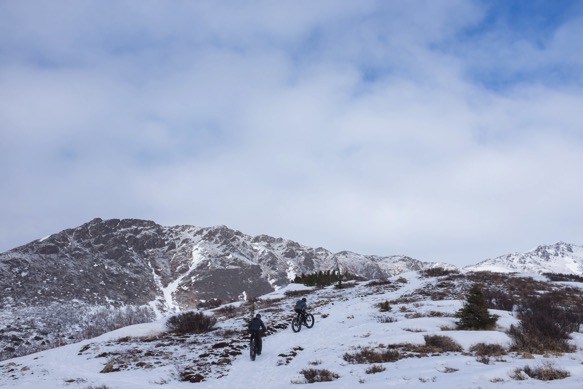
From downtown to the nearby backcountry, all by bike.
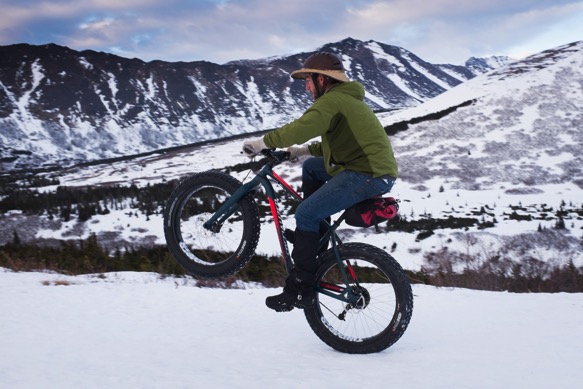
We timed our travels to coincide with Joe Cruz’s arrival in Alaska. We almost never fail to see Joe when our paths cross within a couple hundred miles of each other, such as in Prague, in New Mexico, and for a second time in Alaska. We begin with an epic day ride from Midtown Anchorage into the Chugach Mountains, and back. For cyclists, this is the most unique exit from town. The following day we push out of town to Willow where we begin an overnight journey on the Iditarod Trail. We cross our fingers that rapidly melting snow is still rideable.
Arriving late in the afternoon, we pedal the local Willow Trail System in several inches of fresh snow.

The Willow Trail System, generally designed for snow machines, is well developed and signed, marked much like a network of MTB trails.


By morning, after a long period of bacon, coffee, and light philosophy with Prof. Cruz we push out onto the trail. We connect from Crystal Lake to the Willow Trail System, down the Susitna River, and up the Yenta River.

Alex’s Baja inspired sombrero helmet gets an Arctic ruff, while Joe pedals a brand new Seven titanium fatbike. This is the guy who I thought might never give up his Pugsley.

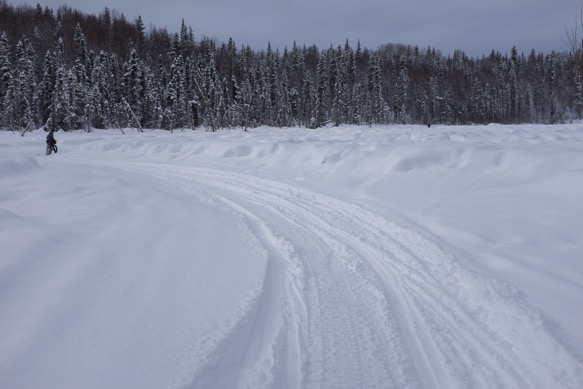

Conditions are good, softening, but rideable. Cold rain falls for a period, lessening our commitment to any particular destination.

We stop at Yenta Station for a beer, enjoying the Iditarod paraphernalia inside. Just upriver, we loosely stake out our pyramid tent in the snow, using our bikes as anchors. Light rain falls through the night, condensation builds inside the structure. By all accounts, it is kind of a miserable night outdoors, but we all manage a sense of humor. Joe pretends not to be uncomfortable sleeping between 6’4” Alex and a drooping wet tent wall. That’s what Joe does.

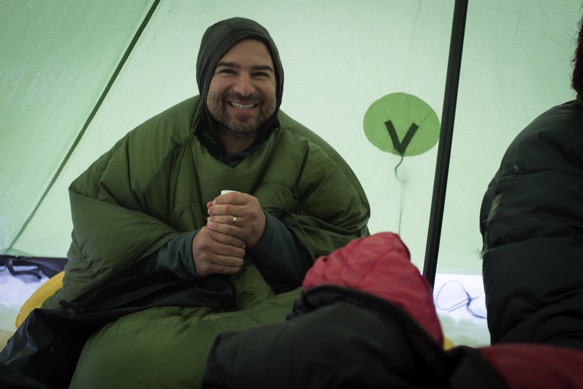
Everyone is happy to point back toward home the next day, as temperatures reach 48F on the river that afternoon.


Snow packs well in such warm weather, so much that the snowman basically made himself. Each section was really heavy.



Talkeetna, again

We return to Talkeetna to visit friends, and make a few laps around the local trails which we’d recently discovered during the Trio. Joe would be spending the following week here, we were excited to show him around. The wide snowmachine width trails make for really fun riding, as they traverse small-scale glacial topography, undulated less than a hundred feet at a time.



Resurrection Pass

Back in Anchorage, days before Joe and the Baja Divide team disband for good, we plan one final outing. Packing four bikes and bodies into the famed Anchorage “short bus” we head for Resurrection Pass trail. We knew it would be warm, but we knew everything would be warm.

We enjoyed a gorgeous day and 7 miles of good hard trail conditions, characterized by mud and wet ice, but nearly all rideable. Once we crossed the creek onto the east side of the valley, we met deeper and deeper snow…

Postholing for about 5 miles to a cabin. Once committed to reaching the cabin, the group opened up into a slow moving pack train. Imagine three of us waist deep in wet denim arriving at a cabin, the fourth shivering and barely concealing curses. Within minutes the hunt for firewood, and both Starbucks Via and blended Canadian Whisky change the tone of the afternoon. Hours later we are drying our pants over the fire, slowly de-robing in the warming cabin, and trading the kinds of stories that are only told deep in the woods with nothing else to do.


White Mountains, again

The final chapter to our winter adventures include a second trip to Fairbanks for the White Mountains 100 race, an event including fat bikers, skiers, and runners, as well as a sole competitor on a kicksled this year.










Overflow is a common concern on this route. Most riders got through the race without getting their feet wet, although a few were less fortunate.

Megan Chelf set a new women’s record on the route. She and her husband Josh now own both the men’s and women’s records on the WM100. Here, Megan is riding up “the wall”.


Lael racing to the finish, completing 100 miles in 10 hours 51 minutes with a lot of climbing and even a little walking. Conditions over Cache Mountain Divide were windblown and soft.

Christina finishes just after dark.

Building a road bike for the Trans-Am Race
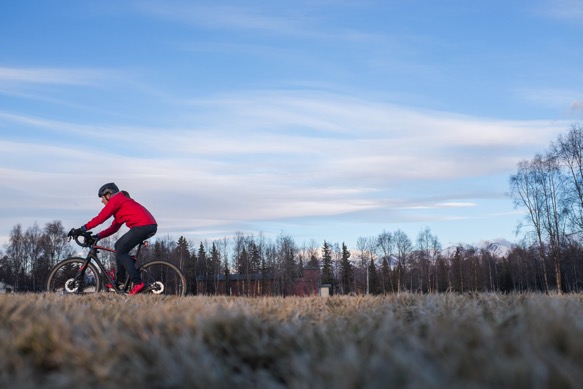
Returning from our winter adventures, Anchorage was quickly moving toward spring with a continuing heat wave. We built Lael’s Specialized Ruby and began customizing it for her ride down to Oregon and for the Trans Am Race.


Our first stop is Revelate Designs headquarters, which is only three blocks away from The Bicycle Shop. When picking up Revelate orders for the shop, we stack boxes of luggage into the baskets of a 1950’s era Schwinn and navigate the streets of Midtown Anchorage.

Bikes for Russian Jack Elementary

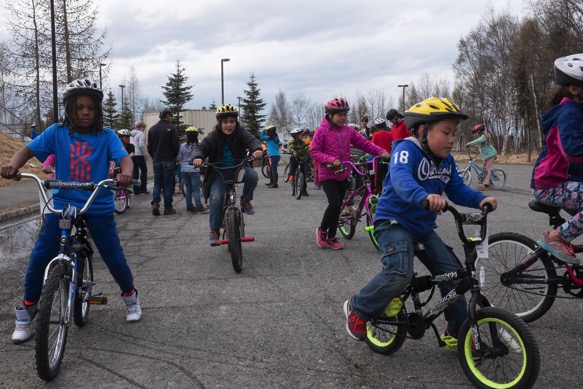
On a series of weekday nights, working until midnight, we organized a one-time program to provide bicycles for two third grade classes at a local Anchorage elementary school where Lael’s mother teaches 3rd grade. With help from friends at Off the Chain Bicycle Collective and The Bicycle Shop, we refurbished more than 25 bikes for students and provided locks and helmets to both classes. The program required a lot of volunteer hours, but was hugely successful. Check out this short video about the project on the Alaska Dispatch News page.
The project required 3-4 nights of intensive bike building and repair, donation collection, transporting bikes from Off The Chain to the school, an afternoon of field trips to Off The Chain, and an afternoon bike rodeo at Russian Jack to present the donated bikes and equipment and to educate students about cycling skills and strategies. Watch the video. The sound of excited children riding bikes is totally worth it.





Riding to the start

Lael left Anchorage on May 1 to ride to Astoria, OR, to the start of the Trans Am Bike Race. Eric Parsons and his son Finn joined us for the ride out of town, along with Lael’s parents. Finn had just received his first big bike, a 16” wheel Redline that he selected with Lael at The Bicycle Shop the day prior.


Lael and I continued to Palmer for the evening and stayed with friends, who housed and fed us for the night. Alpenglow over the Knik River valley.

Lael continued the next day and I returned to Anchorage to make it back in time for work.
To finally see the complete bike in action was exciting, after all the work that had gone into it and all the late nights required in the last month to make ends meet. Riding becomes the quiet meditative time.

This is Lael’s touring load out of Anchorage, including a pair of running shoes, a jumprope, and all of the maps covering the Trans Am Route to study on the ferry.

Godspeed Lael! Enjoy the Trans Am! Follow Lael’s progress on the 2016 Trans Am Bike Race page at Trackleaders.com.













